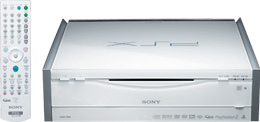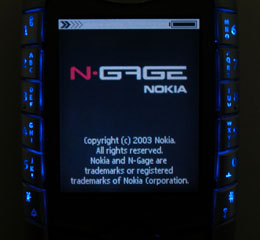By Heidi Jacoby-Ackland
Program your Tivo now. Fightbox, the BBC’s new cross-platform interactive programme, is coming to a TV near you. Robot Wars meets The Sims-on-performance-enhancing-drugs, the BBC publicity machine is very keen to emphasise that Fightbox is a TV first. What, exactly, is Fightbox though? Is it the logical future of entertainment? In development for nearly four years at a reported cost of £3-4 million, Fightbox was conceived from start to finish to cross from the net to television and then into the PC/PlayStation 2/Game Boy Advanced game environments. Early indications for Fightbox are fairly positive and the promotional trails look fantastic.
Initially launched online a few months ago, gamers were drawn in their thousands to the Fightbox downloadable kit for creating their own warriors from a variety of different parts: arms, legs, weaponry, hair colour and even tattoos. Contestants “trained” their self-created warriors on their own PC’s before downloading a set of qualifying battles to practice controlling their creation and gaining a score – the higher the score the stronger the warrior. Then the best scoring virtual warriors (and their real creators) were invited to take part in the production of a television programme. According to the BBC, approximately 200,000 people registered their warriors and uploaded scores in the six-week qualifying period. As a demonstration of the interest in the game, apparently clans have emerged in the online community although they can’t play each other. Yet. It’s all gone a bit D&D.
The nay-sayers complain that the PC controls are, well, hard to control. There’s a rumour that the television production had to be put back a week because the software still had some glitches. And, although the BBC claims that twenty percent of the gamers were women, there’s a rumour that the Fightbox producers were so desperate to attract women that an online appeal was made especially to female gamers. Nonetheless, there’s a low hum of anticipation in the gaming community. Those gamers whose warriors made it to the television round report that the controls are better and the virtual studio experience was wicked. They claim that, as with all the best computer games, practice was key to their success. In the 30-minute television programmes, filmed as-live in front of a studio-audience, the virtual warriors have been transformed by the magic of computer graphics and a new type of filming into, um, virtual warriors in a real arena with real hosts (Trevor Nelson and Lisa Snowdon). The contestant warriors fight the Sentients (the virtual equivalent of the House Robots in Robot Wars) then, finally, go on to fight each other to find a winner. It’s a knock-out competition until just one of the audience-created warriors is left. And for those who participated the ultimate prize was on offer. No, not a million quid record contract for singing out-of-tune but the chance to have their warrior return as a Sentient in the next (yet-to-be-commissioned) series. The final champion may not get rich from Fightbox but he (or she) will get the satisfaction of directly creating a part of the game’s future.
When we asked, the BBC spokeswoman refused either to anticipate viewing figures for Fightbox or even to elaborate on what would constitute a successful outcome to this cross-platform interactive experiment. But it is not inconceivable that the programme could bomb as a television show while, at the same time, creating an enormous buzz for the game itself, either online or at the shop. Then what??? Having already spent the equivalent of some countries’ GDPs on development, it would be imprudent for the BBC to completely bale on the TV programme after just one series even if the ratings are poor. After all, the most costly and time-consuming bit of creating Fightbox, the development, is already done and dusted. Aside from the new Sentient, most of the future content will come from the audience who, in true interactive style, are not voting for a winner but creating the characters and altering the outcomes. The online kit is still available for download at the FightBox site. Although it is too late to qualify for Series One, now would be a good time to start practicing for Series Two.
BBC FightBox
Amazon – Buy the FightBox game on PC, PS2 or GBA
Fightbox Ltd is a joint-venture between Bomb Productions and Ricochet Digital. Fightbox, the TV programme, airs on BBC3 at 19.30 from 13-17 October and continues in that slot for three weeks thereafter. [Episodes will be repeated on BBC3 the following morning at 3.30 and are due to run on BBC2 in November.] Fightbox, the PC/PS2/GMA games, are due for release on 7 November.
 Following the recent launch of Sony’s PSX, which combines the functions of a PlayStation 2, PVR and DVD burner (full details), there have been a number of dissenting voices over the reduced specification of the released product. Despite this, the first shipment to shops is reported to have nearly sold out on launch day, with long queues on the day of its release. The size of the initial shipment has not been disclosed. A spokesperson for Sony added that they plan to ship one million PSX systems by the end of 2004.
Following the recent launch of Sony’s PSX, which combines the functions of a PlayStation 2, PVR and DVD burner (full details), there have been a number of dissenting voices over the reduced specification of the released product. Despite this, the first shipment to shops is reported to have nearly sold out on launch day, with long queues on the day of its release. The size of the initial shipment has not been disclosed. A spokesperson for Sony added that they plan to ship one million PSX systems by the end of 2004. Back in September this year, Nintendo announced they would be creating a home games console that would sell exclusively in Chinese market. Initially to be sold in Shanghai, Guanzhou and Chengdu, this will be the first games console to be sold in China.
Back in September this year, Nintendo announced they would be creating a home games console that would sell exclusively in Chinese market. Initially to be sold in Shanghai, Guanzhou and Chengdu, this will be the first games console to be sold in China.  If true, the impact is far reaching. Games written for the N-Gage will run on any phone running the Symbian operating system and according to Symbian, over 2.68 million handsets were shipped with their OS in the first half of 2003.
If true, the impact is far reaching. Games written for the N-Gage will run on any phone running the Symbian operating system and according to Symbian, over 2.68 million handsets were shipped with their OS in the first half of 2003. After a number of months of speculation, Sony have released the full details the PSX. Combining the ability to play PlayStation games with a television tuner, PVR, ATRAC3/MP3 playback and a DVD player/recorder, the box will also be equipped with a 100Mb Ethernet port – opening the door to the delivery of digital media.
After a number of months of speculation, Sony have released the full details the PSX. Combining the ability to play PlayStation games with a television tuner, PVR, ATRAC3/MP3 playback and a DVD player/recorder, the box will also be equipped with a 100Mb Ethernet port – opening the door to the delivery of digital media.